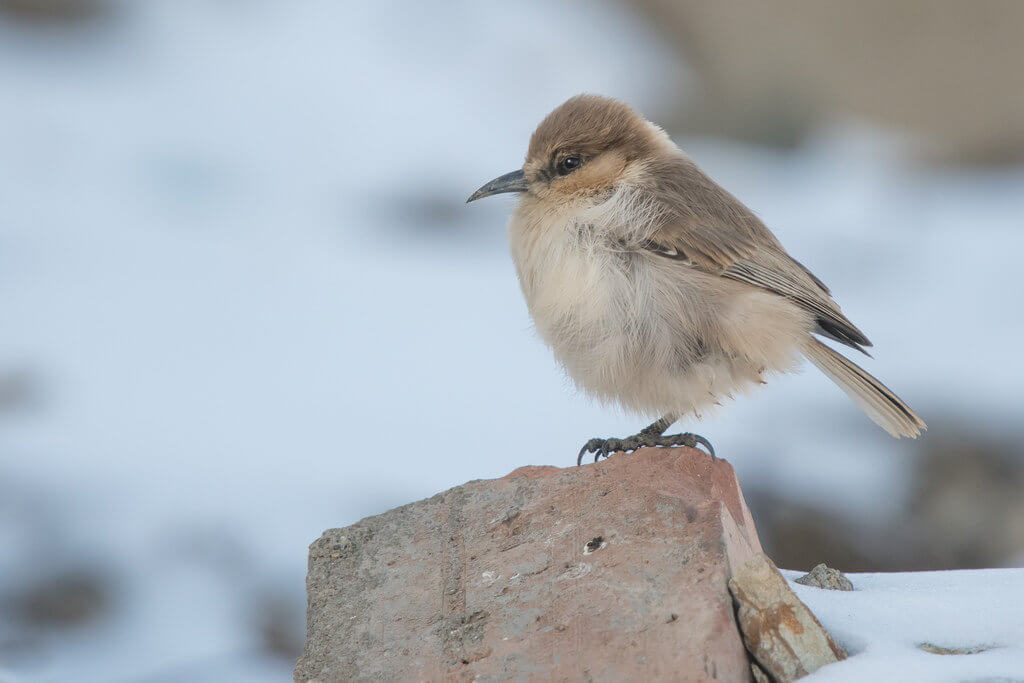
Tim writes: This bird is a lot more interesting than it looks. It was originally called Hume’s Ground-pecker as it uses its long beak to peck the ground. Later it was thought to be a Ground-Jay, and the smallest member of the crow family, being about the size of a sparrow. But DNA molecular sequencing has shown it is definitely a member of the Tit family, with Great Tit as its closest living relative, though it is in a genus all by itself (Pseudopodoces), which translates as false ground-jay. To my mind it resembled a wheatear with a highly-odd bill. It nests at high altitude in the flat, treeless plateaux of the eastern Himalayas in China, Bhutan, Nepal and India, often among colonies of Pikas. It nests in burrows, but despite there being abundant Pika burrows, it excavates the nest burrow itself using its long beak. I photographed this one at 3500m in China, on a snowy day with a solid, frozen ground. Winter in their range is a harsh place, yet they are resident, but sometimes descend to lower altitudes when the weather gets really bad.
[registration_form]
As ever Tim a great photograph with a very interesting accompanying text.
Tim, you’re giving us quite a masterclass in above the snowline Himalayan wildlife – and what fantastic species – it may not be brightly coloured, but what a stunning looking bird the ground tit is, and how on earth do they survive with solid snow cover ? Similarly the Pikas – I imagine everyone has seen them collecting their hay supply for hibernation on TV, but I hadn’t realised there was a species that didn’t hibernate, and again how do they survive ? Lemming- style tunnels under the snow ?
Agree Roderick re Tim’s great wanderings and articles.
The question about adaptation to the cold: – according to Wikipedia another survival trick is that these birds dig burrows to roost in.
On reflection, if that’s true, such behaviour is even more extraordinary than digging nesting burrows – quite a number of various types of bird do this E.g. Sand Martins; Kingfishers etc
However, I think (please correct) the only other bird known to dig out bespoke sleeping chambers is our Tree Creeper (? N American TC and Short-toed TC too). Witness 6 -10 ft up, the lovely scoops in garden and parkland Wellingtonias’ soft very warm bark – behaviour first recorded in Ireland as recently as the start of the 20th C.
The next frosty night take a torch and quietly check out your nearest tree and see one or two Tree Creepers – balls of feathers , with tail protruding downwards, fast asleep, looking very cosy.
But, unlike the Ground Tit, Tree Creepers digging out Redwood bark must be a very recent adaptation because these trees were only introduced to the UK in the 1850’s and it takes a good 50 years for the bark to be thick enough for working.
The likely explanation to this is that Wellingtonia (Giant Sequoia) bark is an analogue for something that used to be common in old growth forests – soft rotten wood. But NOT any old soft decay – crucially it must be bone dry in order to have the same insulating as Redwood bark. Such potential roosting sites can therefore only ever occur in large ancient hulks with its rotten areas sufficiently protected from the weather.
We need, and perhaps Tree Creepers need, much more untidiness in our woods.